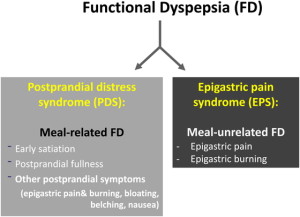<Title:> Recent Advances in the Definition and Management of Functional Dyspepsia
<Author(s):> Hidekazu Suzuki
<Corresponding author E-Mill:> hsuzuki(at)tokai.ac.jp
<Abstract:> In 2016, the Rome criteria were updated as Rome IV, and only minor changes were introduced for functional dyspepsia (FD). The major symptoms of FD now include not only postprandial fullness, but also epigastric pain and burning, and early satiation at above the “bothersome” level. Investigations into the effect of meal ingestion on symptom generation have indicated that not only postprandial fullness and early satiety but also epigastric pain and burning sensation and nausea (not vomiting) may increase after meals. Helicobacter pylori infection is considered to be the cause of dyspepsia if successful eradication leads to sustained resolution of symptoms for more than 6 months, and such a condition has been termed H. pylori-associated dyspepsia. Prompt esophagogastroduodenoscopy and H. pylori “test and treat” may be beneficial, especially in regions with a high prevalence of gastric cancer, such as east Asia. In terms of treatment, acotiamide, tandospirone, and rikkunshito are newly listed in Rome IV as treatment options for FD. Clinical studies in the field of FD should be strictly based on the Rome IV criteria until the next Rome V is published in 2026.
<Keywords:> dyspepsia, bloating, fullness, epigastric pain, epigastric burning
<URL:> https://www.jstage.jst.go.jp/article/kjm/70/1/70_2020-0006-OA/_html


![Clinical Significance of Right Ventricular Function in Pulmonary Hypertension [Published online in advanced , by J-STAGE]](http://kjm.pupu.jp/blog/wp-content/uploads/2021/01/2020-0015-IR-100x100.jpg)
![A Case of Severe Rectal Hemorrhage Possibly Caused by Radiation Recall after Administration of Gemcitabine [Published online Keio J Med, 65, 16-20, by J-STAGE]](http://kjm.pupu.jp/blog/wp-content/uploads/2016/03/2014-0015-CR-100x100.jpg)
![Perception of Thromboembolism Risk: Differences between the Departments of Internal Medicine and Emergency Medicine [Published online Keio J Med, 65, 39-43, by J-STAGE]](http://kjm.pupu.jp/blog/wp-content/uploads/2016/06/2015-0004-OA-100x100.jpg)
![Body Motion and Rowing Performance: Association between Hip Angle and Rowing Performance: A Pilot Study [Published online in advanced , by J-STAGE]](http://kjm.pupu.jp/blog/wp-content/uploads/2020/01/2019-0007-OA-100x100.jpg)
![Cutaneous Metaplastic Synovial Cyst: Case Report and Literature Review from the Dermatological Point of View [Published online Keio J Med, 66, 9-13, by J-STAGE]](http://kjm.pupu.jp/blog/wp-content/uploads/2017/03/2016-0002-CR-100x100.jpg)
![Cardiopulmonary Resuscitation Training in Schools: A Comparison of Trainee Satisfaction among Different Age Groups [Published online in advanced , by J-STAGE]](http://kjm.pupu.jp/blog/wp-content/uploads/2016/06/2015-0009-OA-100x100.jpg)
![Tuberous Sclerosis Complex [Published online in advanced , by J-STAGE]](http://kjm.pupu.jp/blog/wp-content/uploads/2023/08/2023-0011-IR-100x100.jpg)
![Gorlin Syndrome and Cowden Syndrome [Published online in advanced , by J-STAGE]](http://kjm.pupu.jp/blog/wp-content/uploads/2023/08/2023-0010-IR-100x100.jpg)
![Physical Parameters, Use of Specific Medical Treatments, Nursing Levels, and Activities of Daily Living Are Potential Indicators for Forgoing Maintenance Hemodialysis [Published online Keio J Med, 69, 16-25, by J-STAGE]](http://kjm.pupu.jp/blog/wp-content/uploads/2020/03/2019-0001-OA-100x100.jpg)
![Diagnostic Performance of Computed Tomography Imaging for COVID-19 in a Region with Low Disease Prevalence [Published online Keio J Med, 71, 21-30, by J-STAGE]](http://kjm.pupu.jp/blog/wp-content/uploads/2022/03/2021-0012-OA-100x100.jpg)